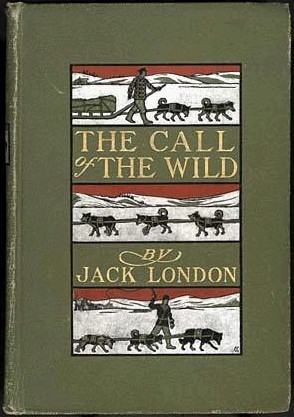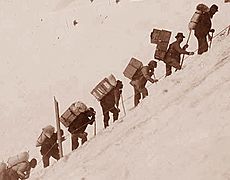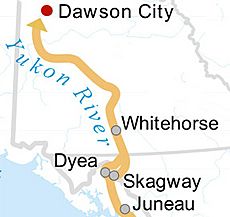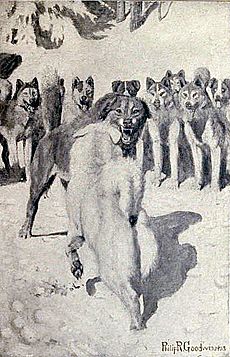The Call of the Wild facts for kids

First edition cover
|
|
| Author | Jack London |
|---|---|
| Illustrator | Philip R. Goodwin and Charles Livingston Bull |
| Cover artist | Charles Edward Hooper |
| Country | United States |
| Language | English |
| Genre | Adventure fiction |
| Set in | Santa Clara Valley and the Yukon, c. 1896–99 |
| Publisher | Macmillan |
|
Publication date
|
1903 |
| Media type | Print (Serial, Hardcover & Paperback) |
| Pages | 232 (First edition) |
| OCLC | 28228581 |
| 813.4 | |
| LC Class | PS3523 .O46 |
The Call of the Wild is a short adventure novel by Jack London, published in 1903 and set in Yukon, Canada, during the 1890s Klondike Gold Rush, when strong sled dogs were in high demand. The central character of the novel is a dog named Buck. The story opens at a ranch in Santa Clara Valley, California, when Buck is stolen from his home and sold into service as a sled dog in Alaska. He becomes progressively more primitive and wild in the harsh environment, where he is forced to fight to survive and dominate other dogs. By the end, he sheds the veneer of civilization, and relies on primordial instinct and learned experience to emerge as a leader in the wild.
London spent almost a year in the Yukon, and his observations form much of the material for the book. The story was serialized in The Saturday Evening Post in the summer of 1903 and was published later that year in book form. The book's great popularity and success made a reputation for London. As early as 1923, the story was adapted to film, and it has since seen several more cinematic adaptations.
One of the more notable earlier films was filmed in 1935, starring Clark Gable and Loretta Young, as well as Frank Conroy and Jack Oakie. Considerable liberties were taken with the story line. Charlton Heston starred in the 1972 version of the movie, which was said to be the version most faithful to the book.
Contents
Summary of the book
The story opens in 1897 with Buck, a powerful 140-pound St. Bernard–Scotch Shepherd mix, happily living in California's Santa Clara Valley as the pampered pet of Judge Miller and his family. One night, assistant gardener Manuel, needing money to pay off gambling debts, steals Buck and sells him to a stranger. Buck is shipped to Seattle, where he is confined in a crate, starved, and ill-treated. When released, Buck attacks his handler, the "man in the red sweater" who teaches Buck the "law of club and fang", sufficiently cowing him. The man shows some kindness after Buck demonstrates obedience.
Shortly after, Buck is sold to two French-Canadian dispatchers from the Canadian government, François and Perrault, who take him to Alaska. Buck is trained as a sled dog for the Klondike region of Canada. In addition to Buck, François and Perrault have ten dogs on their team (Spitz, Dolly, Pike, Joe, Billie, Teek, Koona, Dub, Dave, and Sol-leks). Buck's teammates teach him how to survive cold winter nights and about pack society. Over the next several weeks on the trail, a bitter rivalry develops between Buck and the lead dog, Spitz, a vicious and quarrelsome white husky. Buck eventually kills Spitz in a fight and becomes the new lead dog.
When François and Perrault complete the round-trip of the Yukon Trail in record time, returning to Skagway with their dispatches, they are given new orders from the Canadian government. They sell their sled team to a "Scotch half-breed" man, who works in the mail service. The dogs must make long, tiring trips, carrying heavy loads to the mining areas. While running the trail, Buck seems to have memories of a canine ancestor who has a short-legged "hairy man" companion. Meanwhile, the weary animals become weak from the hard labor, and the wheel dog, Dave, a morose husky, becomes terminally sick and is eventually shot.
With the dogs too exhausted and footsore to be of use, the mail carrier sells them to three stampeders from the American Southland (the present-day contiguous United States)—a vain woman named Mercedes, her sheepish husband Charles, and her arrogant brother Hal. They lack survival skills for the Northern wilderness, struggle to control the sled, and ignore others' helpful advice—particularly warnings about the dangerous spring melt. When told her sled is too heavy, Mercedes dumps out crucial supplies in favor of fashion objects. She and Hal foolishly create a team of 14 dogs, believing they will travel faster. The dogs are overfed and overworked, then starved when food runs low. Most of the dogs die on the trail, leaving only Buck and four other dogs when they pull into the White River.
The group meets John Thornton, an experienced outdoorsman, who notices the dogs' poor, weakened condition. The trio ignores Thornton's warnings about crossing the ice and press onward. Exhausted, starving, and sensing the danger ahead, Buck refuses to continue. After Hal whips Buck mercilessly, a disgusted and angry Thornton hits him and cuts Buck free. The group presses onward with the four remaining dogs, but their weight causes the ice to break and the dogs and humans (along with their sled) to fall into the river and drown.
As Thornton nurses Buck back to health, Buck grows to love him. Buck kills a malicious man named Burton by tearing out his throat because Burton hit Thornton while the latter was defending an innocent "tenderfoot." This gives Buck a reputation all over the North. Buck also saves Thornton when he falls into a river. After Thornton takes him on trips to pan for gold, a bonanza king (someone who struck it rich in the goldfields) named Mr. Matthewson wagers Thornton on Buck's strength and devotion. Buck pulls a sled with a half-ton (1,000-pound (450 kg)) load of flour, breaking it free from the frozen ground, dragging it 100 yards (91 m) and winning Thornton US$1,600 in gold dust. A "king of the Skookum Benches" offers a large sum (US$700 at first, then $1,200) to buy Buck, but Thornton declines and tells him to go to hell.
Using his winnings, Thornton pays his debts but elects to continue searching for gold with partners Pete and Hans, sledding Buck and six other dogs to search for a fabled Lost Cabin. Once they locate a suitable gold find, the dogs find they have nothing to do. Buck has more ancestor memories of being with the primitive "hairy man." While Thornton and his two friends pan gold, Buck hears the call of the wild, explores the wilderness, and socializes with a northwestern wolf from a local pack. However, Buck does not join the wolves and returns to Thornton. Buck repeatedly goes back and forth between Thornton and the wild, unsure of where he belongs. Returning to the campsite one day, he finds Hans, Pete, and Thornton along with their dogs have been murdered by Native American Yeehats. Enraged, Buck kills several Natives to avenge Thornton, then realizes he no longer has any human ties left. He goes looking for his wild brother and encounters a hostile wolf pack. He fights them and wins, then discovers that the lone wolf he had socialized with is a pack member. Buck follows the pack into the forest and answers the call of the wild.
The legend of Buck spreads among other Native Americans as the "Ghost Dog" of the Northland (Alaska and northwestern Canada). Each year, on the anniversary of his attack on the Yeehats, Buck returns to the former campsite where he was last with Thornton to mourn his death. Every winter, leading the wolf pack, Buck wreaks vengeance on the Yeehats "as he sings a song of the younger world, which is the song of the pack."
Main characters
Major dog characters:
- Buck, the novel's protagonist; a 140-pound St. Bernard–Scotch Collie mix who lived contentedly in California with Judge Miller. However, he was stolen and sold to the Klondike by the gardener's assistant Manuel and was forced to work as a sled dog in the harsh Yukon. He eventually finds a loving master named John Thornton and gradually grows feral as he adapts to the wilderness, eventually joining a wolf pack. After Thornton's death, he is free of humans forever and becomes a legend in the Klondike.
- Spitz, the novel's initial antagonist and Buck's arch-rival; a white-haired husky from Spitsbergen who had accompanied a geological survey into the Canadian Barrens. He has a long career as a sled dog leader, and sees Buck's uncharacteristic ability, for a Southland dog, to adapt and thrive in the North as a threat to his dominance. He repeatedly provokes fights with Buck, who bides his time.
- Dave, the 'wheel dog' at the back end of the dog team. He is brought North with Buck and Spitz and is a faithful sled dog who only wants to be left alone and led by an effective lead dog. During his second down-trek on the Yukon Trail, he grows mortally weak, but the men accommodate his pride by allowing him to continue to drive the sled until he becomes so weak that he is euthanized.
- Curly, a large Newfoundland dog who was murdered by native huskies.
- Billee, a good-natured, appeasing husky who faithfully pulls the sled until being worked to death by Hal, Charles, and Mercedes.
- Dolly, a strong husky purchased in Dyea, Alaska by Francois and Perrault. Dolly is badly hurt after an attack by wild dogs, and she later goes rabid herself, furiously attacking the other sled dogs including Buck, until her skull is smashed in by Francois as he struggles to stop her madness.
- Joe, Billee's brother, but with an opposite personality— sour and introspective. Spitz is unable to discipline him, but Buck, after rising to the head of the team, brings him into line.
- Sol-leks ('The Angry One'), a one-eyed husky who does not like being approached from his blind side. Like Dave, he expects nothing, gives nothing, and only cares about being left alone and having an effective lead dog.
- Pike, a clever malingerer and thief
- Dub, an awkward blunderer, always getting caught
- Teek and Koona, additional huskies on the Yukon Trail dog-team
- Skeet and Nig, two Southland dogs owned by John Thornton when he acquires Buck
- The Wild Brother, a lone wolf who befriends Buck
Major human characters:
- Judge Miller, Buck's first master who lived in Santa Clara Valley, California with his family. Unlike Thornton, he only expressed friendship with Buck, whereas Thornton expressed love.
- Manuel, Judge Miller's employee who sells Buck to the Klondike to pay off his gambling debts.
- The Man in the Red Sweater, a trainer who beats Buck to teach him the law of the club.
- Perrault, a "swarthy" French-Canadian, courier for the Canadian government who is Buck's first Northland master.
- François, a French-Canadian "half-breed", "and twice as swarthy" and Perrault's partner, the musher who drives the sled dogs.
- Hal, an aggressive and violent musher who is Mercedes' brother and Charles' brother-in-law; he is inexperienced with handling sled dogs.
- Charles, Mercedes' husband, who is less violent than Hal.
- Mercedes, a spoiled and pampered woman who is Hal's sister and Charles' wife.
- John Thornton, a gold hunter who is Buck's final master until he is killed by the Yeehats.
- Pete and Hans, John Thornton's two partners as he pans for gold in the East.
- The Yeehats, a tribe of Native Americans. After they kill John Thornton, Buck attacks them, and eternally 'dogs' them after going wild—assuring they never re-enter the valley where his last master was murdered.
Background
California native Jack London had traveled around the United States as a hobo, returned to California to finish high school (he dropped out at age 14), and spent a year in college at Berkeley, when in 1897 he went to the Klondike by way of Alaska during the height of the Klondike Gold Rush. Later, he said of the experience: "It was in the Klondike I found myself."
He left California in July and traveled by boat to Dyea, Alaska, where he landed and went inland. To reach the goldfields, he and his party transported their gear over the Chilkoot Pass, often carrying loads as heavy as 100 pounds (45 kg) on their backs. They were successful in staking claims to eight gold mines along the Stewart River.
London stayed in the Klondike for almost a year, living temporarily in the frontier town of Dawson City, before moving to a nearby winter camp, where he spent the winter in a temporary shelter reading books he had brought: Charles Darwin's On the Origin of Species and John Milton's Paradise Lost. In the winter of 1898, Dawson City was a city comprising about 30,000 miners, a saloon, and an opera house.
In the spring, as the annual gold stampeders began to stream in, London left. He had contracted scurvy, common in the Arctic winters where fresh produce was unavailable. When his gums began to swell he decided to return to California. With his companions, he rafted 2,000 miles (3,200 km) down the Yukon River, through portions of the wildest territory in the region, until they reached St. Michael. There, he hired himself out on a boat to earn return passage to San Francisco.
In Alaska, London found the material that inspired him to write The Call of the Wild. Dyea Beach was the primary point of arrival for miners when London traveled through there, but because its access was treacherous Skagway soon became the new arrival point for prospectors. To reach the Klondike, miners had to navigate White Pass, known as "Dead Horse Pass", where horse carcasses littered the route because they could not survive the harsh and steep ascent. Horses were replaced with dogs as pack animals to transport material over the pass; particularly strong dogs with thick fur were "much desired, scarce and high in price".
London would have seen many dogs, especially prized husky sled dogs, in Dawson City and the winter camps situated close to the main sled route. He was friends with Marshall Latham Bond and his brother Louis Whitford Bond, the owners of a mixed St. Bernard-Scotch Collie dog about which London later wrote: "Yes, Buck is based on your dog at Dawson." Beinecke Library at Yale University holds a photograph of Bond's dog, taken during London's stay in the Klondike in 1897. The depiction of the California ranch at the beginning of the story was based on the Bond family ranch.
Publication history
On his return to California, London was unable to find work and relied on odd jobs such as cutting grass. He submitted a query letter to the San Francisco Bulletin proposing a story about his Alaskan adventure, but the idea was rejected because, as the editor told him, "Interest in Alaska has subsided to an amazing degree." A few years later, London wrote a short story about a dog named Bâtard who, at the end of the story, kills his master. London sold the piece to Cosmopolitan Magazine, which published it in the June 1902 issue under the title "Diablo – A Dog". London's biographer, Earle Labor, says that London then began work on The Call of the Wild to "redeem the species" from his dark characterization of dogs in "Bâtard". Expecting to write a short story, London explains: "I meant it to be a companion to my other dog story 'Bâtard' ... but it got away from me, and instead of 4,000 words it ran 32,000 before I could call a halt."
Written as a frontier story about the gold rush, The Call of the Wild was meant for the pulp market. It was first published in four installments in The Saturday Evening Post, which bought it for $750 in 1903 (~$24.4 thousand in 2022). In the same year, London sold all rights to the story to Macmillan, which published it in book format. The book has never been out of print since that time.
Editions
- The first edition, by Macmillan, released in August 1903, had 10 tipped-in color plates by illustrators Philip R. Goodwin and Charles Livingston Bull, and a color frontispiece by Charles Edward Hooper; it sold for $1.50. It is presently available with the original illustrations at the Internet Archive.
Genre
The Call of the Wild falls into the categories of adventure fiction and what is sometimes referred to as the animal story genre, in which an author attempts to write an animal protagonist without resorting to anthropomorphism.
The story is also an example of American pastoralism—a prevailing theme in American literature—in which the mythic hero returns to nature. As with other characters of American literature, such as Rip van Winkle and Huckleberry Finn, Buck symbolizes a reaction against industrialization and social convention with a return to nature. London presents the motif simply, clearly, and powerfully in the story, a motif later echoed by 20th-century American writers William Faulkner and Ernest Hemingway (most notably in "Big Two-Hearted River"). E.L. Doctorow says of the story that it is "fervently American".
Images for kids
-
The Call of the Wild (cover of the June 20, 1903 Saturday Evening Post shown) is about the survival of the fittest.
See also
 In Spanish: La llamada de la selva (libro) para niños
In Spanish: La llamada de la selva (libro) para niños






